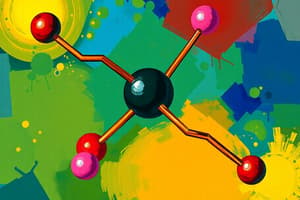Podcast
Questions and Answers
What is the primary characteristic that distinguishes aromatic compounds from nonaromatic compounds?
What is the primary characteristic that distinguishes aromatic compounds from nonaromatic compounds?
- Solubility in water
- Ability to form hydrogen bonds
- Conformity to Hückel’s rule and cyclic structure (correct)
- Presence of a pleasant odor
Which statement accurately describes the Kekulé structure of benzene?
Which statement accurately describes the Kekulé structure of benzene?
- The structure is non-cyclic and contains sulfur.
- Each carbon atom has two hydrogen atoms attached.
- Benzene consists of alternating single and double bonds. (correct)
- The carbon-carbon bonds are all of varying lengths.
Which of the following is NOT a requirement for a compound to be classified as aromatic?
Which of the following is NOT a requirement for a compound to be classified as aromatic?
- Must have hydrogen atoms attached to each carbon (correct)
- Must be planar
- Must be completely conjugated
- Must be cyclic
What does Hückel’s rule state regarding the number of π electrons in an aromatic system?
What does Hückel’s rule state regarding the number of π electrons in an aromatic system?
Which of the following classifications describes a compound that fails to meet the criteria of aromaticity?
Which of the following classifications describes a compound that fails to meet the criteria of aromaticity?
What is a characteristic feature of aromatic compounds?
What is a characteristic feature of aromatic compounds?
Which equation represents Hückel's rule for determining aromaticity?
Which equation represents Hückel's rule for determining aromaticity?
What type of compound is characterized by being cyclic, planar, conjugated, and obeying the equation $4n$?
What type of compound is characterized by being cyclic, planar, conjugated, and obeying the equation $4n$?
In terms of nomenclature, what does the first step involve when naming disubstituted benzenes?
In terms of nomenclature, what does the first step involve when naming disubstituted benzenes?
Which of the following is an example of an aromatic compound?
Which of the following is an example of an aromatic compound?
Which annulene is known to be antiaromatic?
Which annulene is known to be antiaromatic?
What causes the exception in the aromaticity of certain annulenes?
What causes the exception in the aromaticity of certain annulenes?
How is the stability of antiaromatic compounds generally characterized?
How is the stability of antiaromatic compounds generally characterized?
Flashcards
Aromatic Compounds
Aromatic Compounds
A molecule must be cyclic, planar and completely conjugated. It must also have a specific number of pi electrons, 4n+2, fulfilling Hückel's rule.
Antiaromatic Compounds
Antiaromatic Compounds
A molecule that satisfies all requirements for aromaticity but has 4n pi electrons, instead of the expected 4n+2.
Nonaromatic Compounds
Nonaromatic Compounds
A molecule that lacks at least one of the requirements for aromaticity. For example, it may not be cyclic, planar, or completely conjugated.
Benzyne
Benzyne
Signup and view all the flashcards
What are the requirements for a compound to be considered aromatic?
What are the requirements for a compound to be considered aromatic?
Signup and view all the flashcards
Hückel's Rule
Hückel's Rule
Signup and view all the flashcards
Aromatic Stability
Aromatic Stability
Signup and view all the flashcards
Annulenes
Annulenes
Signup and view all the flashcards
Heteroaromatic Compounds
Heteroaromatic Compounds
Signup and view all the flashcards
Monosubstituted Benzenes
Monosubstituted Benzenes
Signup and view all the flashcards
Study Notes
Aromatic Compounds
- Aromatic compounds are characterized by specific chemical and physical properties, not just their odor.
The Phenomenon of Aromaticity
- Benzene is not the same as benzine (petroleum ether), benzyne, or benzin.
- The word "aromatic" comes from the Greek word "aroma," meaning fragrant smell.
- Now, "aromaticity" describes particular chemical and physical properties, not the odor.
Importance of Aromatic Compounds
- Ephedrine, a bronchodilator, is an aromatic compound.
- Chloramphenicol, an antibiotic, is an aromatic compound, particularly effective against typhoid fever.
- Adrenaline (epinephrine), a stress hormone, is an aromatic compound.
The Kekulé Structure of Benzene
- Kekulé (1865) proposed a cyclic structure for benzene.
- Benzene's carbon atoms are bonded together alternately by single and double bonds.
- Each carbon atom is bonded to one hydrogen atom.
- All carbon-carbon bonds have the same length (1.39 Å).
Structure of Benzene Ring
- Benzene has sp2-hybridized carbon atoms.
- The carbons form a planar ring.
- The carbon-carbon bonds are a mix of single and double bonds.
- p-orbitals are perpendicular to the ring.
Requirements for Aromaticity
-
Cyclic: All atoms are in a ring.
-
Planar: All atoms lie in the same plane.
-
Conjugated: Alternating single and multiple bonds.
-
Each p orbital must overlap with adjacent p orbitals.
-
Must contain 4n+2 π (pi) electrons where n is 0, 1, 2.. etc (Huckle's rule.)
Classification of Aromatic Compounds
- Aromatic: Meets all requirements.
- Antiaromatic: Cyclic, planar, conjugated, and has 4n π electrons. Unstable.
- Non-aromatic: Doesn't meet all the criteria.
Examples of Aromatic Compounds
- Benzene: A classic example of an aromatic hydrocarbon.
- Hexatriene: Not aromatic (acyclic).
- Cyclobutadiene: Antiaromatic.
- Cycloheptatrienyl cation: Aromatic.
- Anthracene: Aromatic.
Annulenes
- [14] annulene and [18] annulene are aromatic.
- [12] and [16] annulenes are anti-aromatic.
- Some annulenes (e.g., [8] and [10]) are non-aromatic due to angle strain and non-planarity.
Heterocyclic Compounds
- Pyrrole, pyridine, and thiophene are examples.
Nomenclature
- Substituted benzenes (toluene, phenol, aniline, etc.).
- Disubstituted benzenes (ortho-, meta-, para-xylene).
- Polysubstituted benzenes (naming rules).
Studying That Suits You
Use AI to generate personalized quizzes and flashcards to suit your learning preferences.




